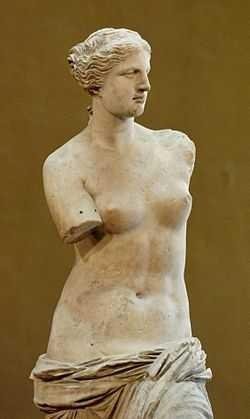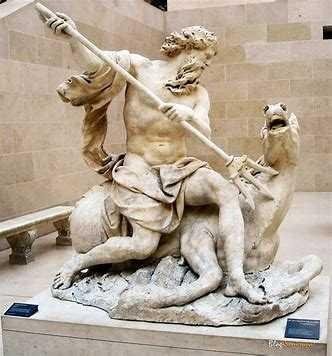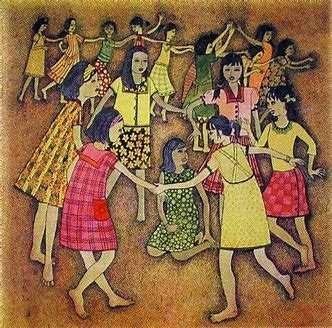History of art.
academic research on the object of art traced through the development of history 
History Art or better known in English as Art History is a study to study the development of art and context of style. These include genres, designs, formats and art styles. [1] This includes studying art in the mainstream such as painting, sculpture, and architecture. Some art in smaller streams such as ceramic art, furniture, and other decorative arts are also studied in art history. 
The history of art includes several methods for studying fine arts; which generally means studying the use of art and architecture. Aspects of this discipline often daling overlap between one another. Art historian Ernst Gombrich once said, "the branch of the history of art is very similar to Galia which is divided into three in the time of Julius Caesar, whose territory is inhabited by three distinct tribes: (i) connoisseurs (people who have a deep understanding of art history) , (ii) art critics, and (iii) art historians from academics ". [2]
As a discipline, art history is different from art criticism, which is more concerned with the relationship between the artistic value of an individual's work with other styles, or supporting that style or movement; and art theory that focuses more on the nature of art. One branch of this science is aesthetics, which includes investigating the riddle of artistic perfection and trying to determine the essence of beauty. Technically, art history does not discuss it, because art historians prefer to use historical  methods to answer questions such as: How do artists create their work? Who are their funders? Who is their teacher? Who is the audience? Who is their disciple? What historical incidents affected their artwork ?, and how did the artists relate to their work ?. Many questions like this are questioned whether they can be satisfactorily answered without thinking of fundamental questions about the nature of the art itself. Unfortunately the gap between art history and art philosophy (aesthetics) precludes the achievement of such satisfaction. [3]
methods to answer questions such as: How do artists create their work? Who are their funders? Who is their teacher? Who is the audience? Who is their disciple? What historical incidents affected their artwork ?, and how did the artists relate to their work ?. Many questions like this are questioned whether they can be satisfactorily answered without thinking of fundamental questions about the nature of the art itself. Unfortunately the gap between art history and art philosophy (aesthetics) precludes the achievement of such satisfaction. [3]
References Edit
^ "Art History". WordNet Search - 3.0, princeton.edu
^ Ernst Gombrich (1996). The Essential Gombrich, p. 7. London: Phaidon Press
^ Cf: 'Art History versus Aesthetics', ed. James Elkins (New York: Routledge, 2006).
# Art painting
Painting is one of the branches of fine arts. On the basis of the same understanding, painting is a more complete development of drawing. 
Painting is the activity of processing two-dimensional medium or surface of the three-dimensional object to get a certain impression. Medium paintings can be anything, such as canvas, paper, board, and even films in photography can be considered as a medium of painting. Tools used can also vary, provided that can give a certain image to the media used..
# The art of Kushan Kingdom
The art of the Kingdom of Kushan is a discussion of the relics of art that flourished during the reign of the Kingdom of Kushan in northern India. Fine art from this region shows the wealth of outside influences entering India through political and commercial avenues. 
Most works from this period are inspired by Buddhism.
# Musicology
Musicology is studying music to experts, usually university professors. People who study musicology are musicologists.

# Broad Definition
Musicology (Greek: μουσική = "music" and λόγος = "word" or "reason") is a scientific study of music. The word is used in narrow, wide and medium senses. In a narrow sense, musicology is limited to the history of Western cultural music In the intermediate sense, it encompasses all relevant cultures and various forms of music, style, genre and tradition. In a broad sense, it encompasses all relevant musical disciplines and all musical manifestations in all cultures. The broad meaning of Stikharion for the word's etymology, the entry of "musicology" in Grove's dictionary, entry on "Musikwissenschaft" in Music at Geschichte und Gegenwart, and Adler's classical approach (1885).
In broad definition, the main disciplines of musicology include history, cultural studies and gender studies, philosophy, aesthetics and semiotics; ethnology and cultural anthropology, archeology and prehistory; psychology and sociology, physiology and neuroscience; acoustics and psychoacoustics; and computer / information science and mathematics. Musicology also has two practical, practical sub-disciplinary centers without parental discipline: performance and research practice, and theory, analysis and musical composition. . The neighboring disciplines of musicology address other forms of art, performance, ritual and communication, including history and theories and plastics of visual arts and architecture; linguistics, literature and theater; religion and theology, and sports. Music knowledge and know-how are applied in medicine, education and music therapy, which can be regarded as the master discipline of Applied Musicology.

Traditionally, historical musicology has been regarded as the largest subdiscipline and most importantly musicology. Today, historical musicology is one of several major subdisciplines. The history of musical, ethnomusicology and systematic musicology is approximately equal in size - if the number of active participants in an international conference is any guide. Systematic musicology includes acoustic music, science and technology of acoustic music instruments, physiology, psychology, sociology, philosophy and computing. Cognitive Musicology is a set of phenomena surrounding the computational modeling of music.
Musicologists study all types of music. They study music history and learn about songwriters and how they develop their ideas and learn from others. Musicologists also study music philosophy.

Music history or musicology studies include: composition, performance, receptions, and music criticism over time, for example concerning the life of a composer, the development of style and genre, the social function of music for a particular group of people (eg court music), or performance mode at certain places and times (eg, Johann Sebastian Bach's choir), as in the field of art history, and the various branches of the school of historical musicology emphasize different types of musical works and different approaches to music.There is also a national distinction in the definition of historical musicology. can refer to the study of the history of every type or genre of music (eg, rock music history history) .In practice the research is more often considered in ethnomusicology and historical musicology assumed to be more inclined to western music art..
Hello! I find your post valuable for the art community! Thanks for the great post! ARTzone is now following you! ALWAYs follow @artzone and the artzone tag, and support our artists!